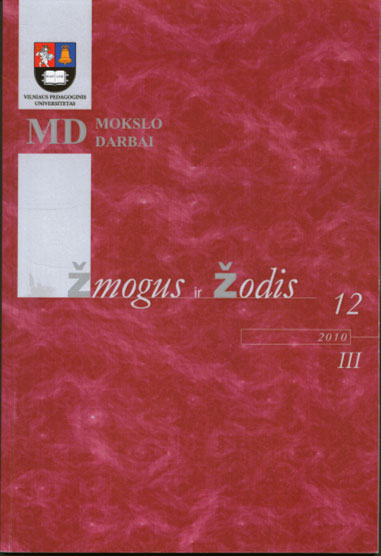Исторические и лингвистические данные о литовцах в Дисненском уезде за 1795–1939 гг.
Istoriniai ir kalbiniai duomenys apie Dysnos apskrities lietuvius 1795–1939 m.
Author(s): Aleksandras AdamkovičiusSubject(s): Foreign languages learning
Published by: Vytauto Didžiojo Universitetas
Keywords: sociolinguistics; Belarusians; Poles; Lithuanians; Russian; Belarusian dialect; the Lithuanian dialect; the Baltic and Slavic culture.
Summary/Abstract: The goal of this article is to observe statistics about Lithuanians in Disnensky County of government of Vilnius, which after V century C. E. located on the frontier of cultures. Baltic and Slavonic civilizations crossed on it, what was reverberate on the specific signs of region, its historical development, sociological, cultural, linguistic, ethnic picture. The first part gives general historical information about Disna county of Vilnius province. The country was established in 1795 and existed until 1939. The second part of the study contains statistics on social, ethnic, national, religious groups residing in the county and languages spoken in the area. According to the first known statistics data for 1857, Disna county’s residents included: Belarusians (49.5%), Poles (39.4%), Lithuanians (1.9%), Jews (6.6%), Russian, 2 6%, of which the Old Believers were 2,5% (Gaučas, 2004, 34). As for the language used in everyday life, the picture was slightly different. Belarusian was spoken by 82% of the population, Lithuanian by 4.2%, Polish by 4,5%, Russian by 2,6%, Yiddish by 6,6%, others by 0,1% (Gaučas, 2004, 47). As you can see, there is a huge difference between the number of Poles and Polish-speakers. This can be explained by the fact that in the middle of the XIX century majority of Belarusians did not have national self-consciousness and many did not identify themselves by ethnicity, but by religion: Catholic meant Pole. And this region had a significant Catholic population (39,4% of the total population) (Gaučas, 2004, 34). There are historical statistics about Lithuanians of the region the next in the article. The history of Lithuanians in Disna county can be divided into two periods: before the assimilation of Balts by Slavs and their massive relocation to the region in the early twentieth century. The Baltic roots in the region are indicated by the names of various localities (Kodesa pine-tree forest), villages (Gedymin, Gechantsy, Girstuny, Purvilishki, Skrabatun, Skudutsy, etc.), rivers (Disney, smooth), lakes (Zhady), as well as the names of many residents (Vazgird , Zhvirba, Mazeikiu, Protas, Puka, Smulka, Tsiunel, Taukina, etc.) (Adamkovičius, Garšva, 2006, 301-310), who themselves did not correlate with the Lithuanian ethnic group and are the indigenous inhabitants of the region. Many such names were slavicized and difficult to decipher. The second period – the massive removal of Lithuanians to this region. The first settlers appeared on the territory of Disnensky county in 1890. For the first time, the dialect of the Roman Catholic parish in Germanavichy was described in 2003 by Kazimieras Garshva. It contains the basic features of the Vilnius dialect and differs slightly from Vidzy dialect. The dialect contains puntininkoima and zhalininkoima. It maintains the quality of long stressed and unstressed vowels. The disappearance of diphthongs is observed, stressed i and u are extended to semi-long or rarely to long.
Journal: Žmogus ir žodis
- Issue Year: 12/2010
- Issue No: 3
- Page Range: 73-79
- Page Count: 7
- Language: Russian

